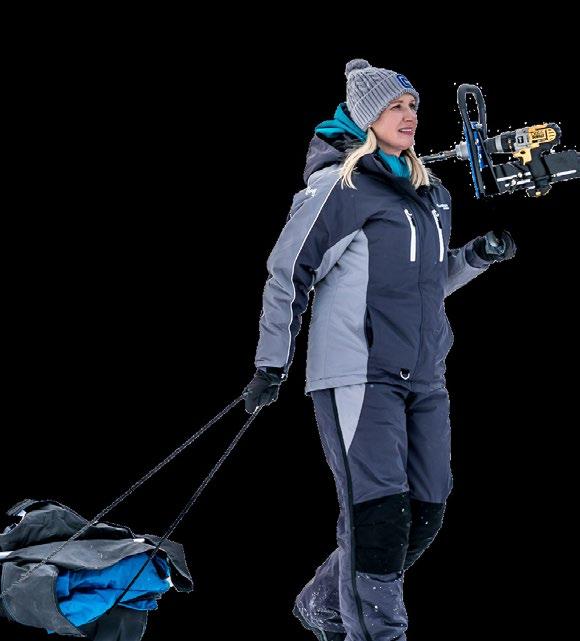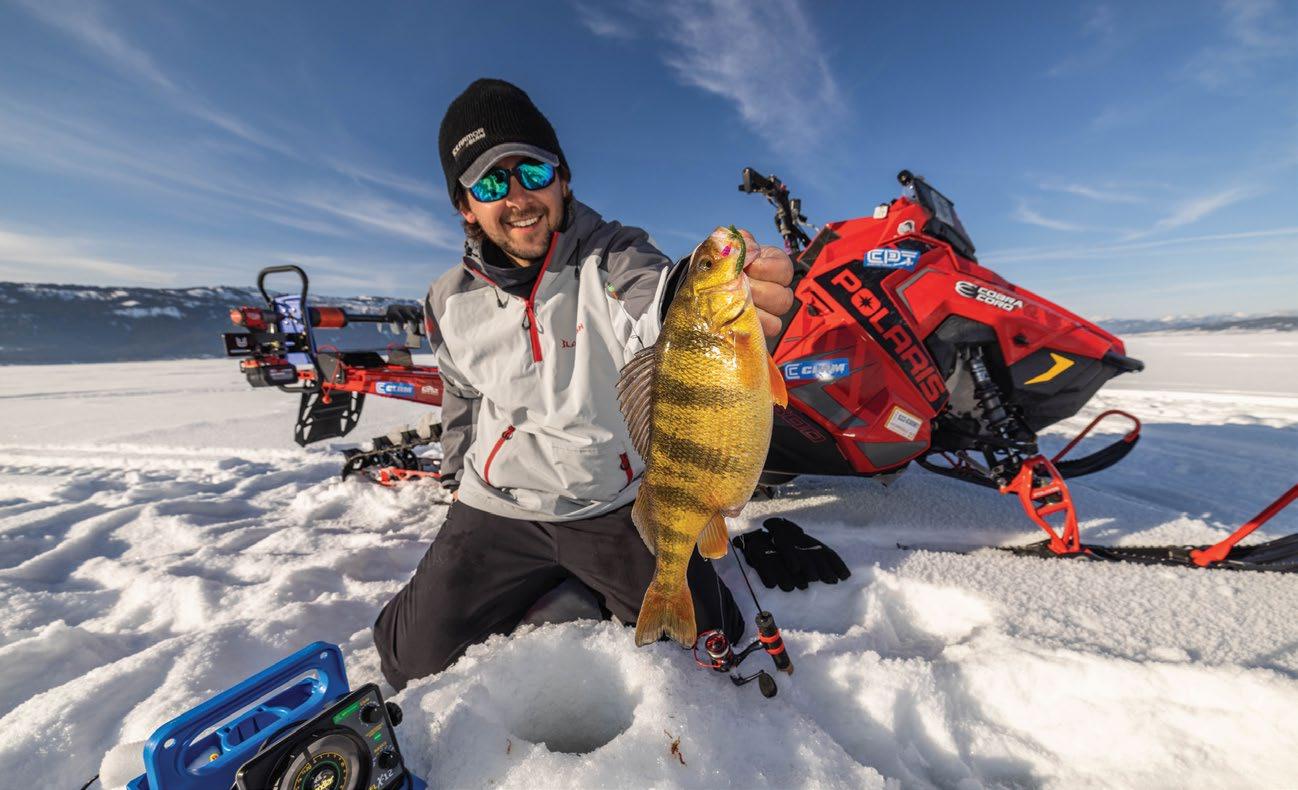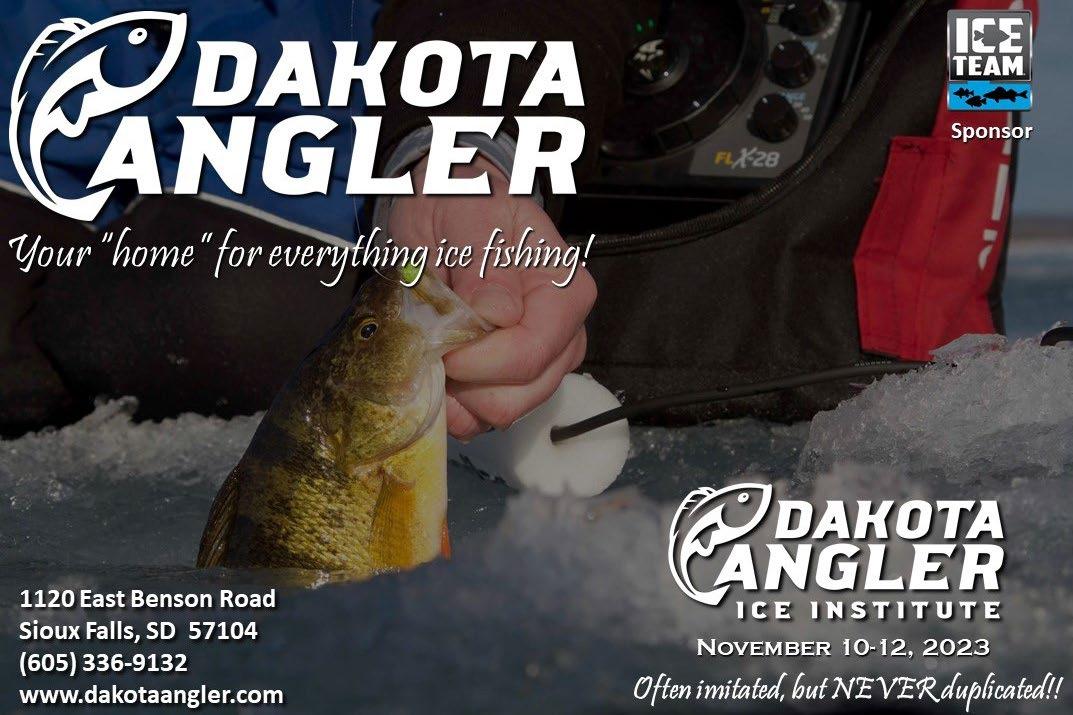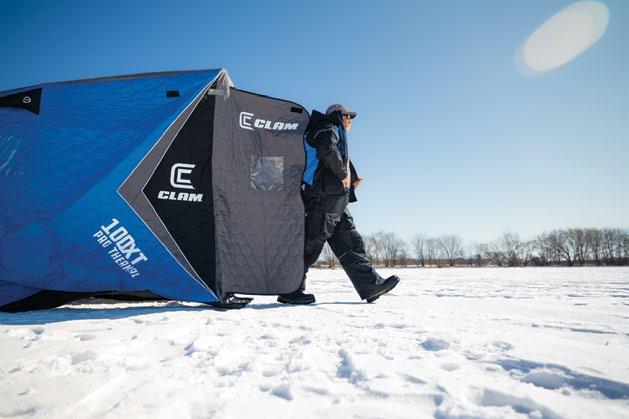
JANUARY ISSUE | 22-2023 THE FROZEN KITCHEN TO COOK, OR NOT TO COOK WARM HANDS FUN DAY FINESSE TACTICS FOR PERCH NEW OPTIONS OLD MEMORIES FIVE TIPS FOR NEGATIVE NELLIES THE ORIGIN OF CHRONICLES BIG ABITIBI PIKE’S FATAL ATTRACTION PLUS



Full line of products at mrheater.com • 800.251.0001
Whether it’s fresh from the lake or straight from the store, your favorite meals are even better with Shore Lunch. Try our breading, batters, soup mixes and more today for a taste of the shore, no matter where you go.
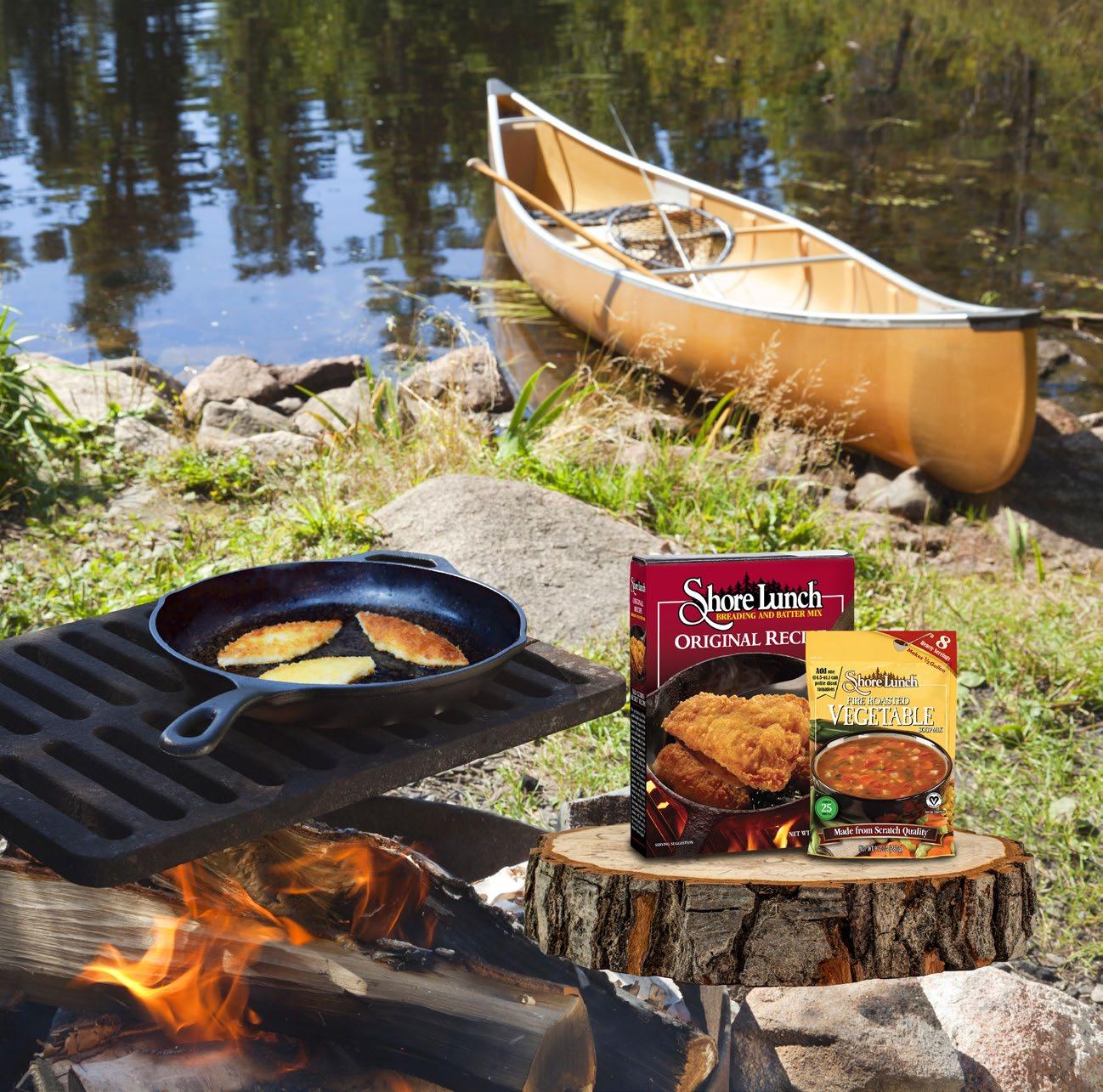
Whatever the catch, we’ve got it covered.
shorelunch.com



DIGITAL Magazine TABLE OF CONTENTS 10 FINESSE TACTICS FOR PERCH 06 WARM HANDS FUN DAY Ice Team Magazine Editors: Matt Johnson Contributing Writers: Felix Goulet, Jason Mitchell, Jason Durham, Ryan Pinkalla, Jerry Carlson, Mike Hungle Adam Bartusek, Steve Scepaniak The True Center of the Ice Fishing World PH: 763 - 231 - 4126 FAX: 763 - 231 - 4121 Email: info@iceteam.com Website: iceteam.com Ice Team Manager Matt Johnson facebook.com/ IceTeamRevolution twitter.com/IceTeamNews youtube.com/IceTeamVideos Advertise with Ice Team Call MSPN at 800 - 989 - 6776 or email sales@iceteamfishing.com Blue42 Agency 17 2nd Street NW Osseo, MN 55369 PH: 612 - 584 - 1395 Email: support@goblue42.com Website: goblue42.com Editorial Director: Matt Johnson Art Director: Brian Lindberg Design: Jeff Bibbs 12 NEW OPTIONS OLD MEMORIES 16 THE ORIGIN OF CHRONICLES 20 BIG ABITIBI 22 PIKE’S FATAL ATTRACTION 26 THE FROZEN KITCHEN 30 FIVE TIPS FOR NEGATIVE NELLIES

When out ice fishing our hands are vital to our success as they allow us to dig holes, bait hooks and feel the bites of the fish inhaling our lures as we jig them.

Warm hands make these tasks easier and much more enjoyable. Where as cold hands and fingers can make the outing uncomfortable and, in the end, potentially ruin an outing if the hands and finger tips start to freeze forcing us to head home early.
When fishing I like to carry 3 different pairs of gloves for myself. The first pair is used while driving my ATV to get on and off the ice and when moving from area to another. My choice of handwear for this purpose is the Clam Renegade Mitts or Gloves.

This is my warmest pair of gloves and since they are so warm and bulky, they aren’t ideal for fishing but they sure do cut down on the cold and windchill impact of moving across the open ice on a motorized vehicle.
My second pair of gloves are lighter gloves that I’ll use while drilling ice holes with a gas auger. The thinner gloves allow me to feel the controls of the ice
auger as I operate it. For auger gloves I like to wear the Clam Waterproof Tactical Gloves or a pair of Clam Edge gloves that are designated as auger gloves. That way my hands stay clean if any gas gets on them as it stays on the outside of the gloves. Additionally, the gas gloves are taken off before I touch any of my fishing rods, ice scoops,
fishing tackle or bait as I firmly believe the that gas odors spook fish.
When fishing I try to fish bare handed as much as possible. However, once my hands start to cool off or I leave the warmth of my ice shelter, I will wear a pair of gloves that allow me to feel my fishing rod while still keeping the cold and wind off my hands. The Clam Fleece Grip gloves are great on chilly days as they cut the wind and provide a comfortable, skin-tight fit that ensures a firm grip and lots of finger movement and feeling. On colder days, I upgrade to a pair of Clan Edge Gloves as these insulated gloves are flexible and allow me to feel what’s happening. In addition, they are waterproof so I can reach into the water or handle fish with these gloves on and not worry about getting cold fingers.
On super cold days, I will wear the Fleece Grip Gloves as liner gloves
WARM HANDS MAKE THESE TASKS EASIER AND MUCH MORE ENJOYABLE. iceteam.com >> Ice Digital January 2023 Issue >> 7
inside a pair of Edge Gloves. The benefit of wearing liner gloves is they wick moisture away from your hands, provide and extra layer of insulation and don’t add a lot of extra bulk in the process.
When fishing carry a small fishing towel and use it dry your hands off if you remove your gloves to handle a fish, bait a hook or reach into a hole to grab a fish that spit the hook. Doing so will ensure the insides of your gloves stay dry and continue to work to keep your hands and fingers warm all day long. I say this as I know from personal experience how uncomfortable it can be to put wet hands into your gloves early in the day and then over the course of the outing slowly have the gloves freeze from the inside out.
After a day of fishing, I will always take my gloves inside the house or cabin and not leave them stuffed in my jacket pockets. Instead, I will put them on a mitt dryer or a furnace register vent to ensure they properly dry out overnight and ready for action the next day.



When my fishing gloves start to smell fishy, I will run them through the washing machine on a normal wash cycle. However, I will not wash my auger gloves with my fishing gloves for fear of getting a gasoline scent on those gloves. When washing lined gloves I put the gloves into a mesh washer bag designed for delicate items. Doing so prevents the liners on the gloves from slipping and ensures the fingers and thumbs stay put and don’t have to be forced back into place. Once the gloves are
washed, I will toss the bag of gloves into the dryer and run on a lower temperature. Every few minutes I will stop the dryer to check the progress of the dryer. When the gloves are damp, I take them out of the dryer, put my hands into the gloves to form them back to my hand and fingers and then finish drying them on a glove dryer or furnace vent.
Chemical hand warmers are also a good product to help keep your hands and fingers warm. They can be placed in pockets when fishing bare handed and you can periodically put your hand into your pocket to heat up your fingers. As well, they can be worn right inside a pair of gloves or mitts. If you plan to use these products remember that they have warm up period before they will reach their effective temperature. With this in mind, you need to activate them prior to needing to use them so you they are warm when some heat.
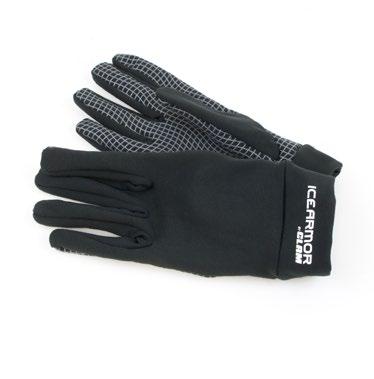


Perch can have a reputation for fast action. The fish that requires moving and drilling holes. Perch can be aggressive and landing on a hot hole is one of ice angling’s most exciting opportunities. Windmilling perch where fish are racing up as you drop down… a fish on before you can close the bail on the reel. A hot perch bite is fun, but fantasy isn’t always reality.
The reality is that as we travel across the upper Midwest and beyond, there are many fisheries and many days where the bite can demand much more finesse. The reality is that perch aren’t always ultra-aggressive. From the shallow backwaters of the Mississippi River to prairie pothole lakes in the Dakotas, there are so many situations where we have to scale down with finesse or dead stick presentations to catch fish.
There are many factors that can contribute to these adjustments. There are days when the fish are in a funk… could be unstable weather or cold snaps but some ecosystems just require added finesse. Even when we fish renowned perch water, we often have to resort to finesse. There is also another reality. Fisheries that can produce big jumbo perch often have lower densities of fish or off the charts forage bases that seem to dictate more finesse.
What is finesse when dealing with perch? Might be the necessity to scale down to small jigs and live bait instead of using a larger spoon and full minnow. Might be the importance of using dead sticks or tip downs with a small minnow pinned off the bottom in one place. Spring bobbers and light line combined with a more toned-down jig stroke might be necessary. Many finesse bites require a certain touch and if anglers are not keyed into these finesse tactics, they can often struggle. Scaling down and developing this touch
can count for a lot more perch on many fisheries.
Besides fishing with more touch, finesse can sometimes slow you down to fish more methodically. To spend more time on spots where you need to have fish pass under you where you essentially run traffic. You might not be able to run and gun with dead sticks or tip downs as effectively for example as these extra rods slow you down. There are days however on many well-known perch fisheries however where this is exactly what you have to do to catch fish.
Small compact tungsten jig designs can be really beneficial when finesse is required. The extra weight of tungsten makes the overall presentation much more sensitive which is an advantage when you do have to scale down. Tungsten also drops back down faster which can mean the difference between three fish and six fish when a school of fish moves underneath you. On the very toughest bites, live bait like a couple of crushed waxworms or a minnow head is often necessary. Other bites enable you to use soft plastics on the jig. What we find is that these small profiles really shine when perch are keying on invertebrates like wigglers, blood worms or freshwater shrimp. With small tungsten jigs, another adjustment that can aid this type of bite is dropping down in line diameter like a three-pound monofilament or six-pound braid. We often use braid particularly over deep-water basins like where we often find perch on Devils Lake. Because of the mouth on a perch, I personally like tungsten that has a wider gap hook that is larger than many of the jigs designed for bluegill or sunfish. The Drop XL from Clam Pro Tackle has this perfect, oversize hook.
Another adjustment is using dead sticks. Dead sticks are often paired with small minnows or
sometimes wigglers depending on where you fish. The Mississippi River backwaters are famous for the “rosy” bite where anglers believe that the bright colored pink or orange color mutation on fathead minnows produces more fish. Tip downs are popular for perch set lines in many regions. Either way, a small minnow on a set line can produce perch when nothing else will. Set lines can be as simple as a number six plain hook and a single split shot. Gogebic Lake and the use of wigglers on dead rods comes to mind. There are times on Devils Lake where a tiny minnow below a dead stick will count fish when nothing else works.
The reality in our travels, we probably encounter more perch fisheries that demand different levels of finesse versus fisheries where the bite is overly aggressive. This level of intensity can also change from day to day or even by the hour. Especially when there is a lop-sided forage base where fish have ample opportunities to eat, finesse more often than not saves the day.
Perch 1: Perch don’t always demand an aggressive run and gun style of fishing. Many ecosystems require various levels of finesse.
Perch 2: Dead sticks with small minnows or wigglers will trigger tough perch that won’t lift off the bottom or accelerate towards your presentation.
Perch 3: Your Vexilar will tell the story. When perch are aggressive, they often move fast and will lift off the bottom. When you see fish following the fish you are reeling in and they rise up in the water column… these fish will respond to more aggressive presentations and much larger lure profiles. When fish won’t rise in the water column or scatter as you reel in a fish, rely on finesse.
iceteam.com >> Ice Digital January 2023 Issue >> 11


Every year I have a list of lakes I frequent on a regular basis. I know these lakes fairly well and have my goto spots locked in on my GPS.
It is always amazing to me how the panfish in these lakes have a tendency to return to the same locations year after year. That is a good thing for me as I make use of this pattern to consistently put fish on the ice.
A classic example of this concept can easily be seen by looking for a cluster of houses on a lake. These ice fishing shanty towns crop up in the same spots year after year. Granted, some years are often better than others in terms of fish production, but the basic concept of returning to the same deep basin does have some merit.
With that said, I am not always satisfied with fishing the same spots over and over. This is especially true during some years when the quantity or quality of the fish is not up to my standards. Even on really good years, I feel the need to wander a bit. It’s the “grass is greener” concept.
Last year was a classic example of my need to check out something different. I guess it was due to some old memory that had me recalling a winter of quality fishing on a lake that is not usually on my radar.
My memory served me well as I located the deep basin on this particular lake. I even recalled the part of the basin that the panfish liked to frequent.
As I went through my routine for locating fish, I stumbled across a good school of suspended something that showed up on my Vexilar. After drilling out a half dozen holes in the vicinity, I dropped a jig down to see what would bite. It didn’t take long before I had a ten-inch crappie flopping on the ice.
The mixture of gills and crappies kept me busy for a while. As I sorted through the eager biting fish for ones to take home, the predicted snowstorm arrived. When I could no longer see the shore or much of anything else, I packed up and headed home.
This lake that I had not fished for years turned out to be my breadand-butter spot for the entire winter. Although I certainly found fish on other lakes, there was not another place that was as consistent as my “old memory” lake.
This is not the first time I have had ice fishing seasons like this. Lakes do cycle through good and bad years. This is especially true when talking about crappies. For this reason, it is always a good idea to occasionally sort through those old memory lakes to see what the current conditions might happen to be.
It does take time to for this exploration process to take place, but if you plan your travels right, more than one lake can be on your radar for some of your outings. If your explorations don’t pan out, hit one of your go-to lakes next.
If you are like me, you may be surprised how many times new ice fishing options materialize from chasing down old memory lakes.
iceteam.com >> Ice Digital January 2023 Issue >> 13
LAKES DO CYCLE THROUGH GOOD AND BAD YEARS. THIS IS ESPECIALLY TRUE WHEN TALKING ABOUT CRAPPIES.
STAND YOUR GROUND.




The most convenient way to ensure your tailbone won’t meet that hellaciously hard ice, just strap the Apex Ice Cleat on, grab your auger and start punching holes knowing there’s no ice condition these babies can’t sink their teeth into.











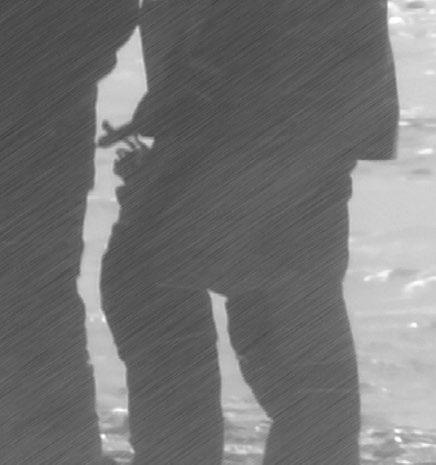


20 MULTI-DIRECTIONAL, SAW-TOOTH STAINLESS CLEATS FOR THE ULTIMATE TRACTION AND QUICK MOBILITY.






AT SHEEL’S, CABELA’S AND OTHER FINE OUTFITTERS.
APEX AVAILABLE

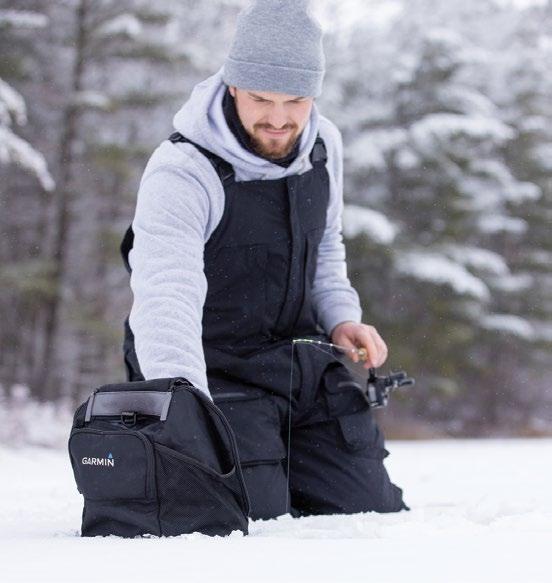
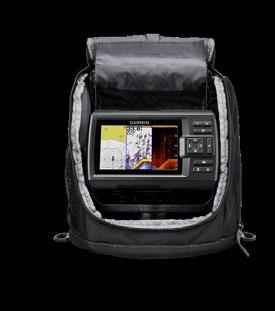




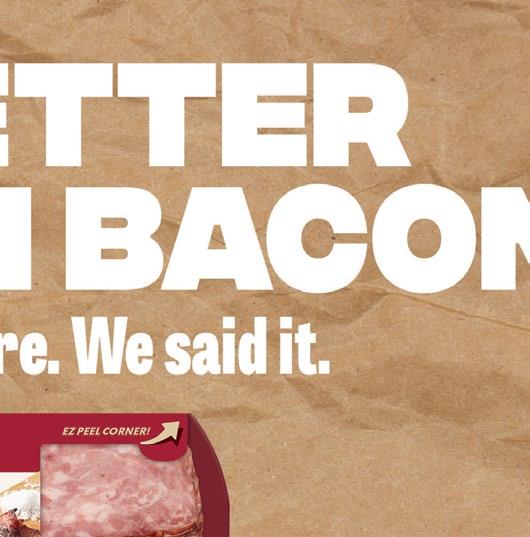



Connect with us @scheelsoutdoors SEE WHAT’S BELOW SHOP HERE ICE FISHING FINDERS

As another ice season has settled into the north, a crew of anglers begins to build their houses, spool their lights, tie their jigs, and prepare for a marathon of a season.
That crew, made up of Ice Team Pro’s Adam Griffith, Matt Waldron, Ryan Pinkalla, and myself (Adam Bartusek), would be the team behind The Crappie Chronicles.
Heading into Season 3 of production, The Crappie Chronicles has become a winter staple to the YouTube viewing regimen of ice anglers across Minnesota, and the Midwest. Focusing on chasing the largest crappies most anglers have ever seen, right under everyone’s noses, in the Twin Cities Metro Area. Whether it’s the countless number of crappies over 15” the team has put on film, the unique cooking segments that consistently push the envelope of creativity, or all of their unique personalities; this team has assembled quite a following in short order.
But where did this idea come from, and how did all of this start?
Well, we dive back into the winter of 2017, December specifically. I (Adam Bartusek) had taken over filming responsibilities of a small group of young anglers across the Midwest, Team Yukon Outdoors, after Sam Sobieck (Sobi) had just left that fall to go film full time for APBassin’ on YouTube. We had started the filming season in early November of 2017, as it was a REALLY early freeze. This is the last and only time I ever remember walking on ice close to Halloween. We were able to put a 1lb 13oz & 2lb Bluegill on camera in the same day, which was absolutely ridiculous. As well as an early Red Lake walleye show before Thanksgiving.
After grinding in Northern Minnesota for most of November and early December, I was back home for the Holidays, and wanted
to film a couple shows, and this is where the story really begins. I called a friend I’d met through Clam and Vexiilar at the Ice Shows, Adam Griffith, to see if he wanted to hop out on early ice to film. At this time, Griffith had never filmed a show and hadn’t even really begun his guide business yet. However, he was tearing apart the Minnesota Tournament Ice Fishing scene, and Griffith basically just said, “Sure, why not?”
Griffith and myself ventured out to one of their favorite Metro Lakes, filmed a show, and BI headed home. Pretty standard filming day, nothing really crazy happened until… on my way back to my apartment in the Twin Cities, I was called by one of my best friends, Matt Waldron, and all that was said was, “Bart, it’s going down right now.”
With a quick detour, reloading of the ice gear, and draining camera batteries, we filmed the 2nd episode of the day, and broke my PB at that time for a Black Crappie. Shortly after, I filmed 2 more episodes in the Metro over the Christmas Season. Thus, beginning a Metro Crappie Mini-Series that would debut on the Team Yukon Outdoors YouTube Channel, gaining immediate attraction.
Now, we fast forward to the winter of 2020. I had begun my own media company, Bartusek Media Management, over the summer after losing my job because of the COVID-19 Pandemic. It was around Thanksgiving, and I’d run out of new work, and to be completely honest I was really worried about the future of my self employment. I’d started debating sending in job applications and giving everything up. I didn’t think I was cut out for it. However, I decided I was going to give everything one really hard push over the early ice crazy.
So I called Waldron while he was at work at Vexilar, asked if he’d want to bring back to life the Metro Crappie Series we’d filmed 3 years prior, to which he said absolutely. I didn’t really plan on pursuing any sponsors that heavily, as it was more of just a passion project and something I wanted to do. But Waldron called me back later in the day saying he thought of the name, “The Crappie Chronicles” and that Vexilar would sponsor it. Quickly after Clam came on board along with Ice Hole Power, Thorne Bros., and Amped Outdoors.
Once I knew I had a little bit of funding I called Griffith, told him about the idea and he agreed to give it a shot in December and we’d see where it would go.
I really can’t explain how crazy the few weeks after that were, but it was honestly life changing. I’m not necessarily the most religious person in the world, but I think the universe positively rewards us when we’re doing what we’re supposed to be doing.
And WOW did we get a sign.
On Tuesday, December 15th Griffith and I were able to sneak onto a smaller metro lake and film the first Episode. I’d previously been out on the ice with the guys filming some random stuff, but we’d never really connected as the early ice bite had been pretty tough and nothing was freezing quickly. But, we had Episode 1 done and I edited for about 36 hours straight to get it ready to post Thursday, December 17th.
The first weekend we filmed really hard was December 17 – 20th of 2020. A friend I’d made on Social Media though the bass fishing world, Matt Pangrac, had decided to venture north for his first experience ice fishing. Matt got up and on that Friday we went to tour Vexilar then go hit some early ice. We caught them really good,
iceteam.com >> Ice Digital January 2023 Issue >> 17
but nothing crazy big, I think our biggest fish was around 13.5”.
But with that great content I decided to call another friend, Ryan Pinkalla, to see if he wanted to do a Catch and Cook type video. All he said was, “Yes, let’s do it, but I’m going to go ham. I don’t want to do one of those basic Frank’s Red Hot cooking fish videos.”
And that is how Ryan Pinkalla came onto the scene.
Pangrac and I drove back to my place in Lakeville, Waldron came over, we cut up a bunch of fish, and Ryan cooked the first segment we had where he made Crappie Skewers and Blackened
Fish Tacos. It was so much fun, and the food was so good.
Simply put, everything just felt “right” at that moment. The next 2 days we ventured into some backwaters to chase giant river crappies, which we were given some absolute gifts; including an estimated 16.5” – 17” Crappie, and I broke my PB White Crappie with one just a hair over 15” the next day.
That first week we filmed the first 4 episodes of The Crappie Chronicles. And the rest is history.
Now, we’re heading into Season 3 of The Crappie Chronicles, and if you were to tell me in November of 2020 I’d be here right now, I would
call you crazy. I tell people routinely, I’m the luckiest man in the world. I get to film all these insane ice fishing experiences and adventures with my 3 best friends in the world. If it wasn’t for The Crappie Chronicles, I don’t think I’d still be a Freelance Videographer and Photographer today.

The Crappie Chronicles made me, and every single day of the ice season I try my hardest to make sure every viewer knows how thankful I am for that.
And now, The Crappie Chronicles has a lot of surprises and adventures in store for Season 3, and we can’t wait to keep pushing the envelope.
18 >> iceteam.com >> Ice Digital January 2023 Issue
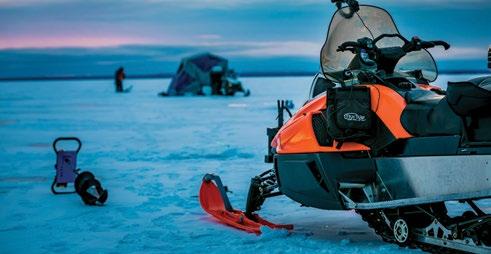









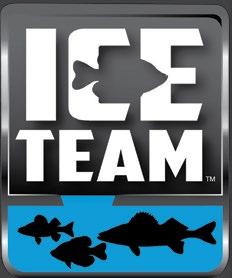

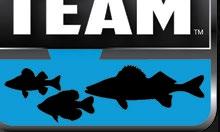
HIGH-PERFORMANCE SNOWMOBILE SKIS www.caproskis.com | 1-888-321-6789 RACING xt • Mini xt • mini MOUNTAIN/UTILITY bx • Mtx bx • mtx CROSSOVER xcs xcs TRAIL xpt • RZ xpt • RZ Maximum Floatation Utility Skis Ideal for Ice Fishing! Mtx mtx Official Skis of the CLAM ICE TEAM iceteam.com
Igrew up on the shores of this huge body of water. Ever since I can hold a rod in my hand, I have fished this beautiful lake located in northern Québec. In fact, lake Abitibi is divided by the border between Québec and Ontario. The lake is 931 km² and you can count 900 islands. It is separated by a deep narrow portion, but the rest of the lake is extremely shallow, averaging 8 feet deep. It measures 90 km long and 22 km wide and the water is very muddy because of the bottom composition of sand and mud.
The lake is difficult to fish in the summertime because of the dirty water. The best period is from the opening week-end in may and the first few weeks thereafter. The absolute best time to hit big Abitibi is in winter. The fishing is fantastic, and you can catch big walleye, tons of sauger and huge pike. You can also catch a lot of mooneye and ling. The nonstop action is a must on lake Abitibi. You can easily catch 50 fish or more in one day, with the chance to hook into a couple of monster walleye and pike.

Strategy
If you want to have success on this lake you must drill a lot of holes. The numerous islands and points can all be good spots. Fish are everywhere, but you must find them. The best month to hit big Abitibi is December at first ice and late in March and April near the end of the season. You also catch fish in January and February, but the fishing is slower. You will often be fishing in 2 to 4 feet of water below the ice. Due to the shallow water, it is very challenging to get a big fish in the hole and the battle is furious.
My favorite strategy is to fish with a jigging rod and to install a few tip-ups. I drill a lot of holes to cover a large area. I place a couple of tip-ups and fish the other holes with my electronics and jigging stick. On my tipup I just tie a simple #4 hook baited with a dead minnow and I place it about 6 inches above the bottom. These tip-ups do the job for me, and if I see that a certain area is paying off I concentrate my efforts in the vicinity of the hot hole.
What to tie on
I use three different presentations on my jigging rod. A jig and minnow combination for lazy fish, a spoon and small minnow for neutral fish and finally on aggressive fish, a minnow shaped bait like the Clam Pro Tackle Tikka minnow. These three presentations are always ready on three different rods to not waste any time dropping a different lure down the hole. If a fish shows up on my electronics and refuses to bite my presentation, I switch to another presentation which usually is a less aggressive approach.
The first lure that I always tie up is a simple jig head. My favorite is the Drop XL Jig by Clam Pro Tackle. These tungsten jigs have a verry solid hook and the small profile of the bait provides very subtle movement that triggers non-active fish. For this type of lure, I use a 32-inch medium power rod. The soft tip of this rod allows me to imply subtle movements to my bait which will tempt the fish into biting. Place the hook point into the mouth of the minnow and pass it through the skull between the eyes and jig very slowly. When I see a fish coming in on my screen and it won’t hit, I will sometimes just leave the bait in a static position which will sometimes entice the fish to take the bait.
Spoon and minnow
One of my go to lures is a simple spoon baited with a small minnow or just a minnow head. I like to tie a light spoon with a lot of surface area to reflect a lot of light under the ice. My favorite spoon is the 1/8 oz Leech Flutter spoon. The gold and red one is a must on Big Abitibi. The technique is very simple, just hook a small minnow, here I’m talking about 2 inches long, take one of the hooks and pass it trough the skull gently between the eyes. It is very important to hook the minnow like this to optimize the action of the spoon. If I have bigger minnows, I just put a minnow head. You can take scissors or your fingers to cut off the head of the minnow. Some guys prefer to cut it with their fingers to have an uneven cut which releases more odor.
There are many ways to work the spoon. Personally, I drop the spoon and stop it 8-10 inches above the bottom. Next, I raise the rod 20-24 inches and let the spoon freefall back to the bottom. I do this maybe 2-3 times to attract fish. After this sequence I pause and watch my electronics. If a fish comes in, I raise the bait slowly to make it chase the bait. If this doesn’t work and it refuses to bite, I drop the spoon directly to the bottom and raise the spoon slowly while subtly shaking my rod tip to make the spoon vibrate. Sometimes, I just leave the spoon completely still and just focus on my rod tip to feel the bite.
My choice of rod for this technique is a 36-inch medium stick. I prefer a longer rod to have the possibility of a longer jig stroke if necessary. The soft tip, gives me the opportunity to imply subtle movements to my presentation. Pair this rod with a small reel spooled with 10-pound test braid and an
8-pound fluorocarbon leader and you have a good combo to fight any size walleye or pike.
Minnow shaped bait
Finally, when fish are very active and feeding, I love to fish with a minnow shaped bait. My go-to is a 1/16 or 1/8 oz Tikka minnow. The action of this bait is incredible. You can cover more water under the ice and the erratic movement can provoke big active walleye to bite. Two of my favorite colours are the glow fire tiger and glow red tiger. Glow colours work well in the sediment rich water of Big Abitibi.
I will sometimes bait this type of lure with the tail or the head of a small minnow. This little piece of minnow gives off some smell that will convince reluctant fish to bite your presentation. I like to use a 32 to 36-inch medium heavy rods to fish minnow shaped baits. Don’t be shy and raise your rod vigorously to snap the bait and let the bait freefall back to its original position. By doing this you will maximize the attraction of this type of lure.
If you want to come to Big Abitibi, don’t forget to bring a good GPS. This lake is huge and if a snowstorm passes over your head it is very difficult to find your way. I recommend snowmobiles instead of ATV’S to travel on the ice due to the snow thickness. Also, beware of slush as there are some spots that can be rather slushy. Finally, the scenery on Big Abitibi is breathtaking and seeing moose, fox or wolves is a real possibility depending on the part of the lake you choose to fish. Be safe and have a great ice fishing season.
iceteam.com >> Ice Digital January 2023 Issue >> 21
Winter ice fishing for pike has gained in popularity by leaps and bounds. Many anglers wait patiently for late ice to target trophy sized pike staging in the shallow waters waiting for the upcoming spawn. And there are others who try their luck throughout the ice fishing season in hopes of catching a sizeable pike.
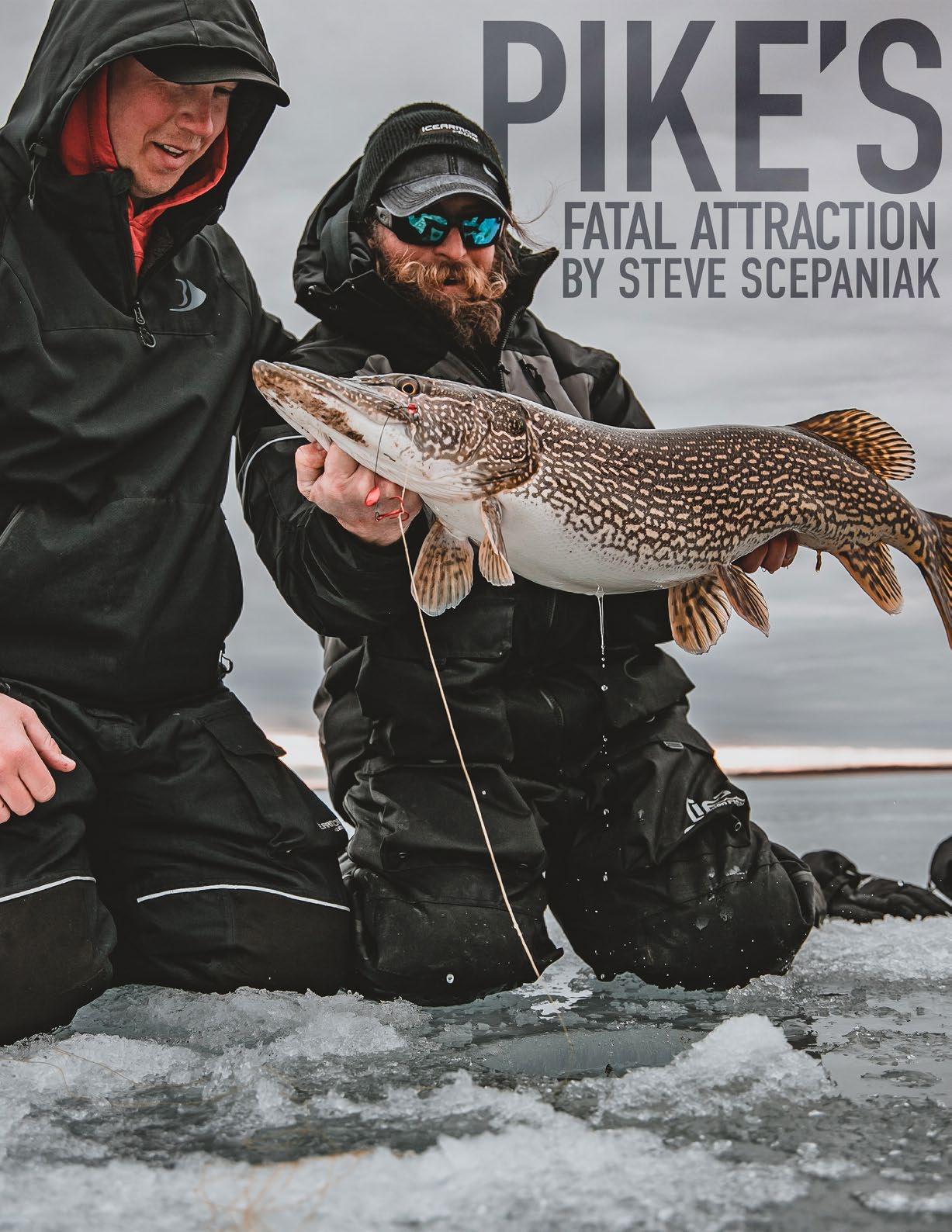
There is a simple and easy solution to put the odds in your favor any time of the hard water season to ice that trophy you’ve been hunting for. That simple solution is the use of an attractor. Attractor’s come in many forms, shapes and sizes. Their main goal is to attract pike to your minnow or lure. But
first you have to cut two holes in close proximity of six to ten feet apart from each other. One is for your Clam Trophy Thermal tip-up and the other for your attractor. Good attractors for old ESOX are spearing decoys, large and small spoons, large sized lake trout jigs and smaller sized Muskie lures. These miniature sized Muskie lures from their much larger counterparts adds a special flair to attractors. The ones that offer a set or sets of tentacles or a single tail are hard for any pike to resist as well. Keep in mind these miniature Muskie lures never get seen during the hard water season.
The key of the decoys success is the molded curvature of the tail (some have a metal tail that
needs to be bent a little). When pulled fairly quick the decoy rotates upward and does a complete oblong circle returning to where it began. Start working the decoy near the bottom and gradually work it upward in the water column till you are about four feet under the ice. Lower it back down and repeat the process. Repeat this process about three times then move on to the next holes to work them as well. When working the decoy the entire sequences should take no longer than one minute. After all the holes are worked, wait ten to fifteen minutes and repeat the process on all the holes. Color definitely plays a key factor for your decoy attractor. White body with a red head and tail, yellow body with black trim on back and fins, pike imitation, chartreuse and the list goes on and on and on. When working the decoy I like to attach it to eighty pound test super braid used for fishing. The heavier line allows you to pull the decoy with authority and add erratic action as well.
Spoons are fun to work as well. Start near the bottom and lift four to five feet up and then let go of the line so the spoon flutters seductively and slowly back toward the bottom. This slow side to side flutter is hard for pike to resist. Leave the hooks on the spoon. Besides a lively minnow you are attracting the pike to it could just as easily inhale the spoon. Do not let the spoon hit the bottom. Instead keep it off the bottom by putting a bobber stop pre-set to where it is one foot from the bottom. Each time you work it and the bobber stop nears the surface of the water, you know it’s time to stop it. Good colors are red and white, black and white, nickel, gold and hammered gold. Again the list is endless.
Miniature sized Muskie plastic lures have their own unique action when properly worked. Tie your line directly to the main eye hook on the head. Drop near the bottom and lift to within a couple feet of
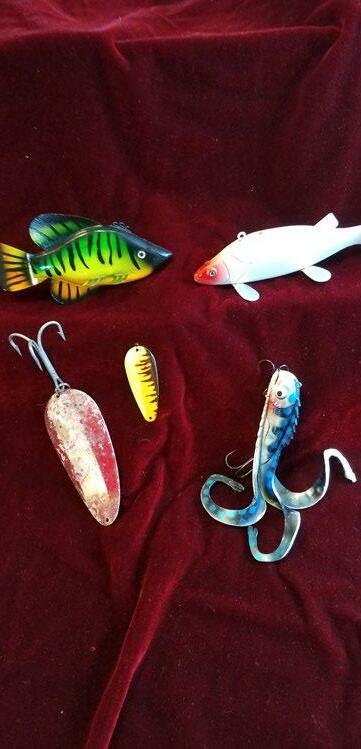
the surface and like the spoon, let it flutter down on a loose line. The dynamic shape of the body keeps it horizontally stable as the tentacles flutter seductively down near the bottom. When raising up each time, lift with a teasing action by stopping and shaking the line up and down about two to three inches then raise up a foot or two and repeat till the desired shallow depth. Drop down and repeat. Lift and drop three times then move on to the next hole. Leave the hooks on these lures. Like the spoons, they can and will catch pike on their own at times. Employ the bobber stop to set your depth.
Without a doubt, location is pinnacle to being successful. Throughout the ice fishing season, weed beds will be the pikes primary haunts till late ice pushes them towards the shallows in preparation for the up-coming spawn. Concentrate your tip-up sets of the weed bed on every
point, pocket and inside turns. These strategic areas offer the pike the perfect ambush locations when fishing. The points offer a pivotal turning spot for the other game fish and bait fish that utilize the weed bed as well. The pike will set up on one side of it or the other. Thus catching their quarry of guard. The pockets and inside turns give the pike the advantage of hiding within and being able to ambush their prey from the sanctuary and cover of the weed bed. Again offering the top line predator an easy meal to enjoy.
Midsized mid-lake humps with weed beds are another perfect location for pike. Set your tipups around the perimeter of the hump. Weed bed flats or large humps near shore are key places to finding pike. As season progresses, these areas offer other species of fish the opportunity to move in for a different smorgasbord of forage to feast on and the pike are right there behind them to take advantage of an easy meal as well. In these locations look for spots that are void of weeds. No weed bed is a lush thick carpet of continuous weeds. There will be open spots with no weeds at all. Look for the thickest parts of weeds on the flats or humps. Imagine a thick forest if you would. The heavily wooded cover will hold more game. Same is true with the weeds. The thickest, largest area will hold the most pike and at times the largest. Again, in these spots set up on every deviation within the bed, sharp inside turns, long tapering points and deep pockets within.
While the pike can be targeted in many ways, there is no doubt when you start to implement other tactics to coach them in, it becomes obvious what’s the “Pikes Fatal Attraction.”
Steve Scepaniak Predator Guide Service
iceteam.com >> Ice Digital January 2023 Issue >> 23

• Best performance & features • Best sunlight-readable display • Best reliability • Best resale value • Best customer service • Best reputation Vexilar, Inc. 6667 West Old Shakopee Road, Suite 101 Minneapolis, MN 55438 952-884-5291 • www.vexilar.com A Tradition Built To Last. Vexilar.com

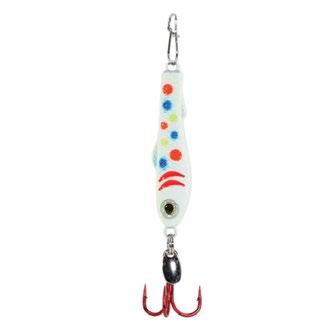






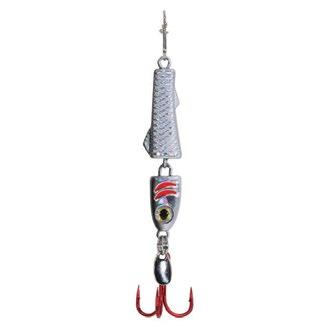

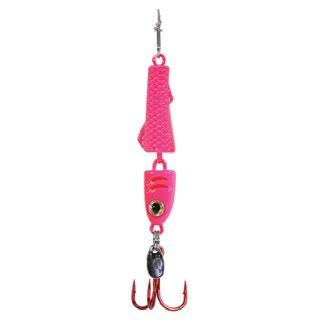
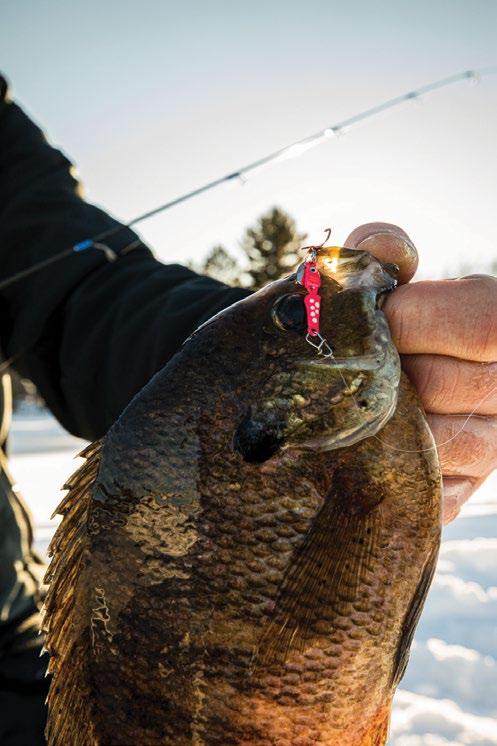
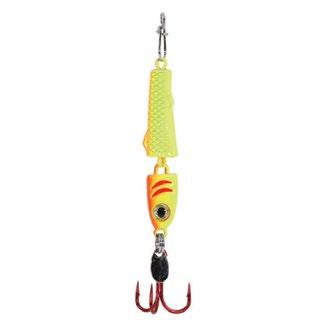



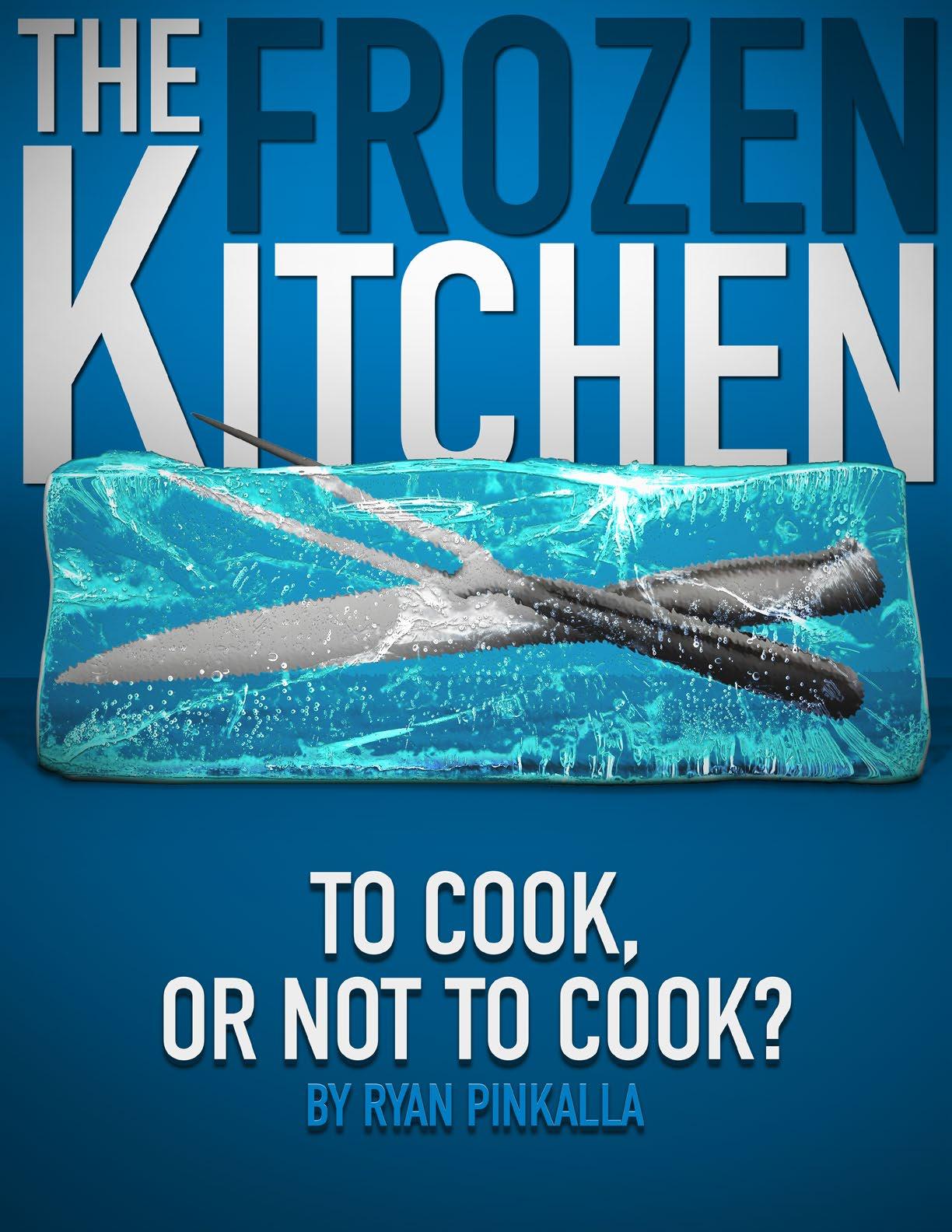
26 >> iceteam.com >> Ice Digital January 2023 Issue
After a long day on the ice, it’s hard to beat some good hot food. If it was a successful day on the ice, you may even find yourself in possession of some exceptionally fresh fish just waiting to be turned into something delicious. It is at this moment that you realize you really don’t have a lot of ingredients laying around, you are so hungry you begin
contemplating whether or not crappies can be eaten raw and the gas station breakfast you ate at 6am is sounding like a 5-star dining experience. Sometimes cooking elaborate recipes just isn’t in the cards and having a few ideas to pull out at a moment’s notice can make all the difference when deciding to cook up your catch or save it for another day.
Getting big flavors out of fish dishes doesn’t need to take a long time. With a short list of ingredients, you can go from zero to delicious in no time. This recipe for spicy crappie skewers is crazy simple and should all come together in under 15 minutes from start to finish.
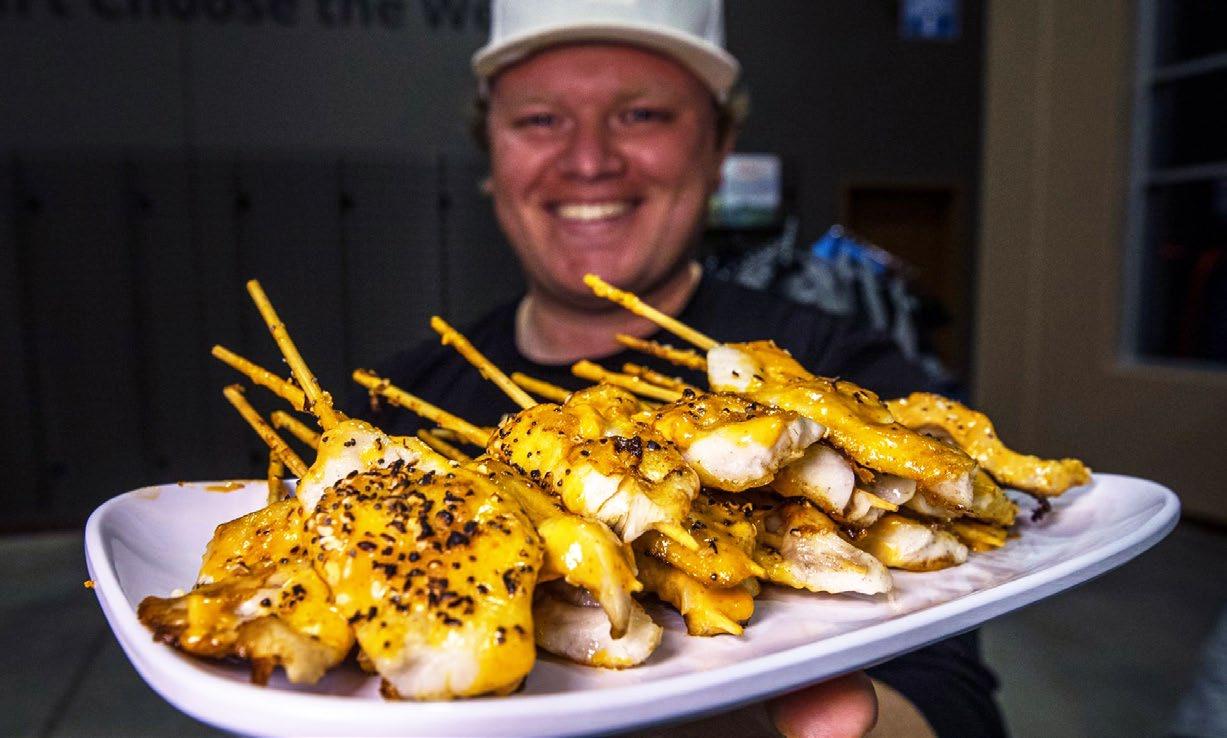
•
•
•
Black pepper
•
•
•
•
5. 6. 7. INGREDIENTS:
Start by cutting each fillet lengthwise into ¾ inch wide strips.
Ribbon the crappie strips onto the skewers. Fish should cover 3-4 inches of a 6” skewer.
Drizzle olive oil over fish to lightly coat both sides. Season with salt and black pepper.
Assemble the sauce by mixing together mayonnaise, sriracha, paprika, garlic powder. Add salt and black pepper to taste.
Preheat a large pan or griddle on medium high heat. Lay skewers into pan and cook 2 mins. Flip. While the second side is cooking use a basting brush to brush sauce onto the cooked side. Once second side has cooked 2 mins. Flip one additional time and brush sauce onto second side.
iceteam.com >> Ice Digital January 2023 Issue >> 27
1 ½ pounds crappie fillets
¼ cup mayonnaise
2 Tbs
sriracha
1-2 tbs olive
oil
Kosher
salt
2. 3. 4.
1.
Use a small kitchen torch to caramelize mayonnaise then remove from pan. (If you are not using a torch turn the pan heat up to high for 30 seconds on each side). Serve. METHOD:
½ tsp paprika
¼ tsp garlic powder
6” wood skewers (soaked)
This recipe was featured on the Ice Team Podcast Episode #10 with the Crappie Chronicles crew. https://youtu.be/kTSWLUkCQx4?t=1428









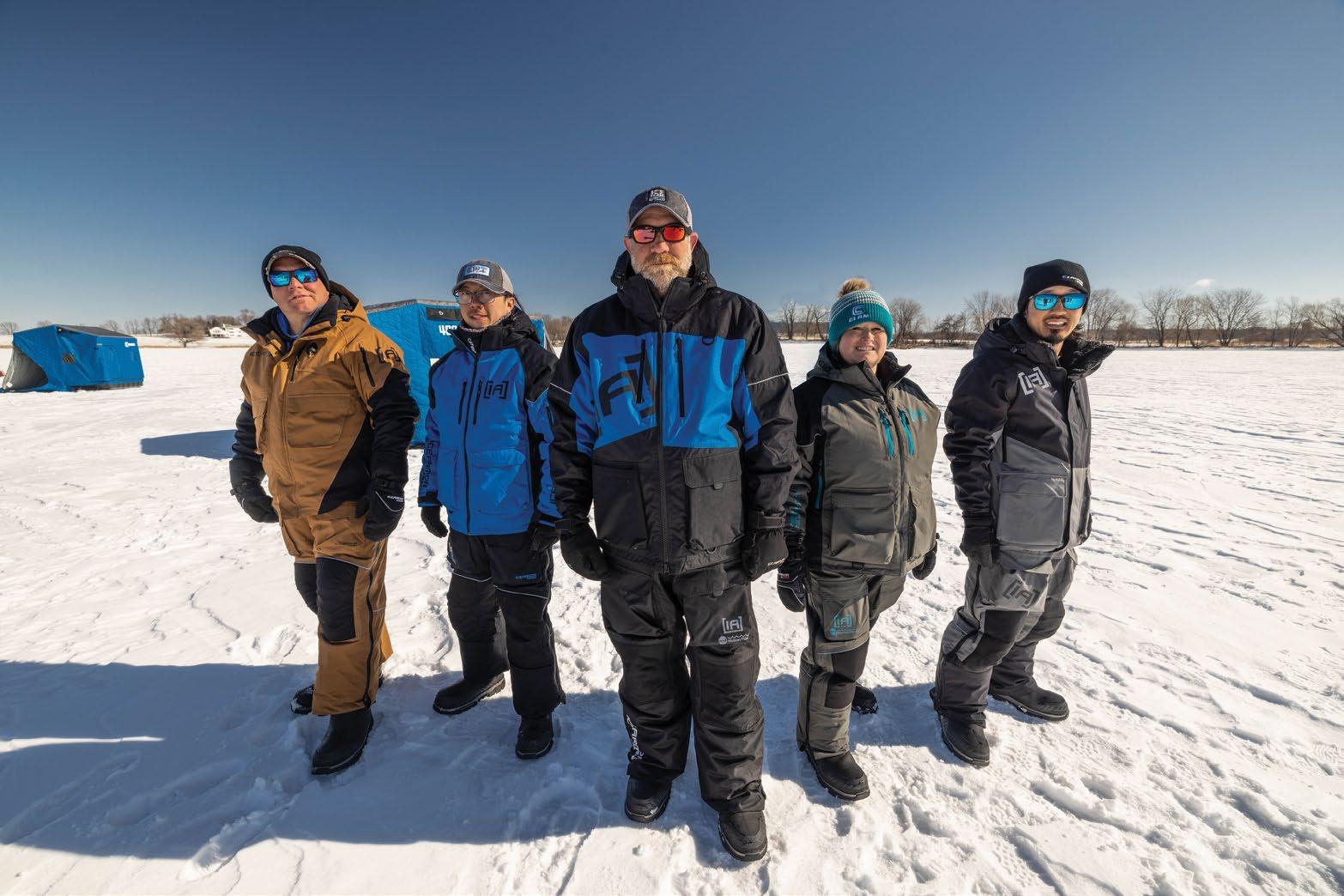
Connect with us @scheelsoutdoors GEAR UP WITH w Connect with us @scheelsoutdoors PORTABLE + WARM






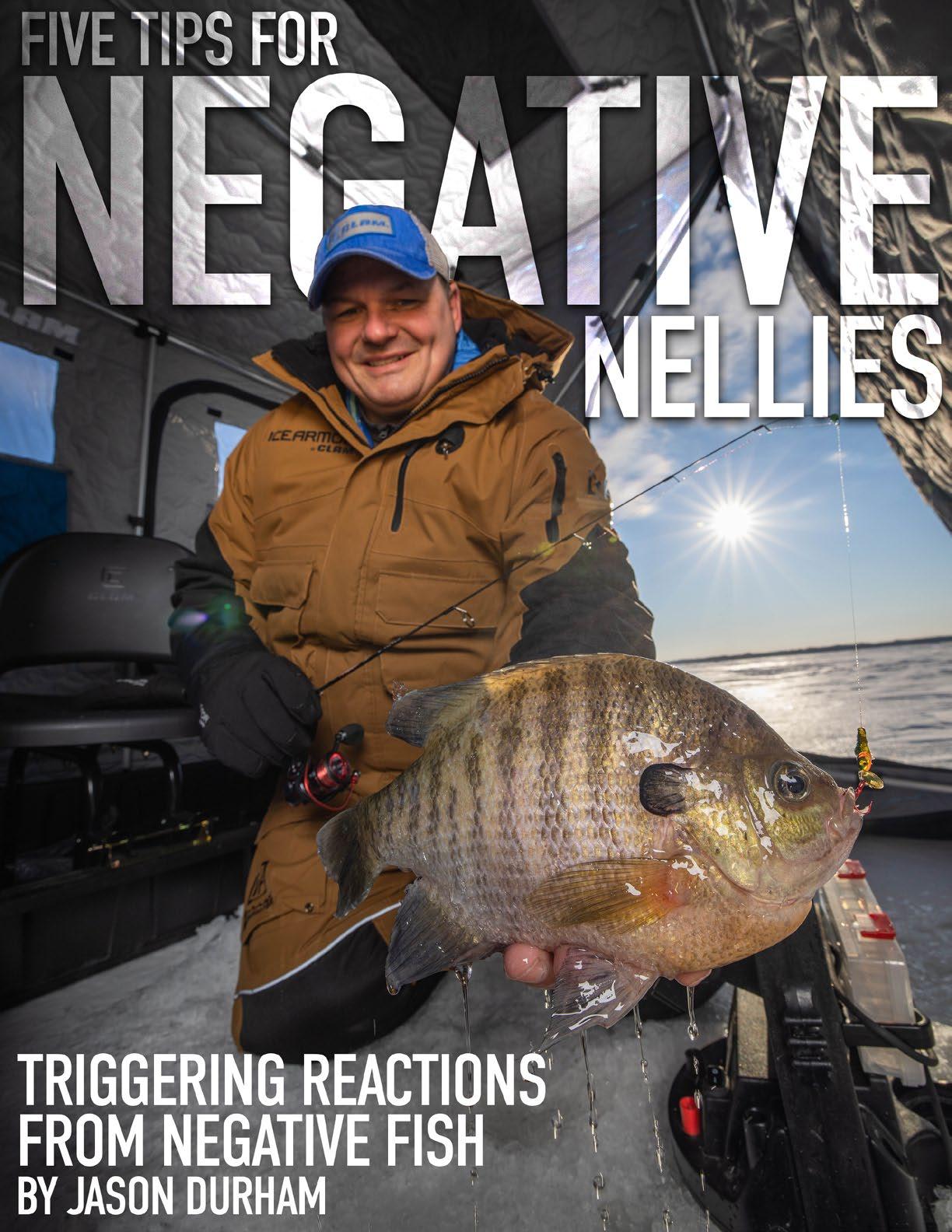
Of course we all enjoy the days of steady activity and bragging about catching fish “as fast as you could put your line down”. However, no angler in history has ever been able to avoid days when the fish were flat out grumpy. Melancholy. Downright negative.
There are numerous environmental factors that can contribute to fish behavior. The list is lengthy and are all great excuses after a subpar day on the ice.
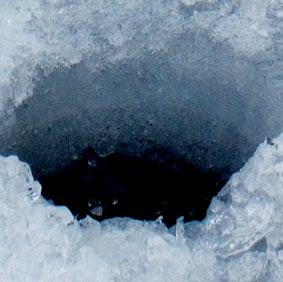

“It was too sunny.”
“Too windy.”
“There’s too much snow, they can’t see.”
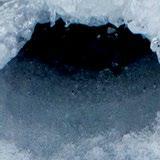

“Boy, that barometer.”
There truly are situations where it’s not you, it’s the fish. However, if you’ve ever participated in a fishing tournament or perused the results following an event, you’ll see that despite negative fish behavior and the majority of the field referencing their list of excuses, someone always catches them. Even when the fish are ill-tempered, there are steps you can take to increase your odds. The next time you encounter fish with a case of the Negative Nelly’s, try these five tips:
Tip #1. Downsize



Downsizing, reducing the size of your presentation, is regularly referenced, especially if you’re a seasoned angler. However, most people only consider the size of their bait as the item to downsize, but there’s more to it. Switching to a lighter line and subsequently a lighter rod is all part of the equation. Being able to visually see those ultra-light bites is imperative when the fish barely mouth your bait. Missing a bite, or executing a poorly judged hookset can be avoided by matching your presentation, line and rod, all in synchrony.
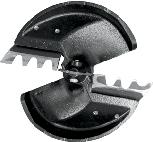
Ice rods
compared to open water Watch the K-drill in action at kdrillauger.com Made By AWC 6667 West Old Shakopee Rd, Suite 102 Bloomington, MN 55438 952-224-3649 Patented Technology #7,946,355 & #10,544,626 Order direct on-line now or get one at your favorite tackle shop kdrillauger.com Official Member K-Drill is Made in the USA ` Requires ½" drill chuck (see web site for recommended drills) ` Foam float prevents the drill from sinking ` Thermal wrap on light weight aluminum shaft ` Durable composite flighting ` Drill through 36" of ice without extension (12" and 18" extensions available) ` ` Large center point for safer drilling of old holes ` FREE blade sharpening for the life of the product (see web site for details) 6" 7.5" 8.5"
are relatively inexpensive
counterparts, so it’s not uncommon for today’s angler to own several combos and have them along on an excursion, but anglers tend to become overly comfortable with what usually works for them; several rods of the same model and weight with identical line on every one. It’s more of a “in case one breaks” situation. Instead, think of your rod arsenal as a socket set, with each one playing a unique role. Make sure your rod, line and presentation follow that philosophy.
Tip #2. Relocate
For years, successful ice anglers have preached that mobility equates to a higher level of success. Today’s high tech ice fishing equipment makes it easier than ever to do so. Get out your phone, look at the contours on your Navionics or Humminbird FishSmart apps, and go check out the next area.

To be clear, there are times when relocating is your first step. We’re talking about negative attitude fish, not the complete absence of fish, in which case downsizing typically does nothing for your catch success rate. You can’t catch fish where there aren’t any fish. But if there are fish present, approaching your bait or swimming through your sonar signal and not committing to your presentation, revert to tip #1. However, it’s also important to positively identify the species of those deniers. It’s all too common for anglers to spend considerable time and effort to catch fish that aren’t the intended species. For instance, tullibee and small perch often provide consistent hope with activity. Don’t be afraid to drop down an underwater camera and positively identify what type of fish are actually present.
Tip #3. Call up the Army
There’s strength in numbers and ice fishing is a great example of this. Having more lines in the water, a greater variety of presentations and a work force to quickly cut holes and cover water is a huge advantage. Just be sure you’re willing to have information shared
32 >> iceteam.com >> Ice Digital January 2023 Issue
between your group when you do land on an eagerly active school of fish. Understand that in the days following your striking it rich on some of the nicest fish you’ve ever seen, one friend might bring another friend, someone makes a mention of it to a neighbor, one of the angler’s posts results on social media, etc. and your secrets aren’t secrets anymore.

Tip #4. Ring the Dinner Bell Downsizing can be effective, but when ice fishing, no matter how mobile we’ve become, we ultimately have to convince the fish to approach our presentation. We might land directly on top of a school of crappies…and then they wander off.


Using large, flashy, loud presentations can sometimes get those fish to come back into the vicinity due to curiosity versus actually wanting to ingest the offering. In other words, use one very aggressive approach but have another rod with your downsized presentation available to quickly

















































































































